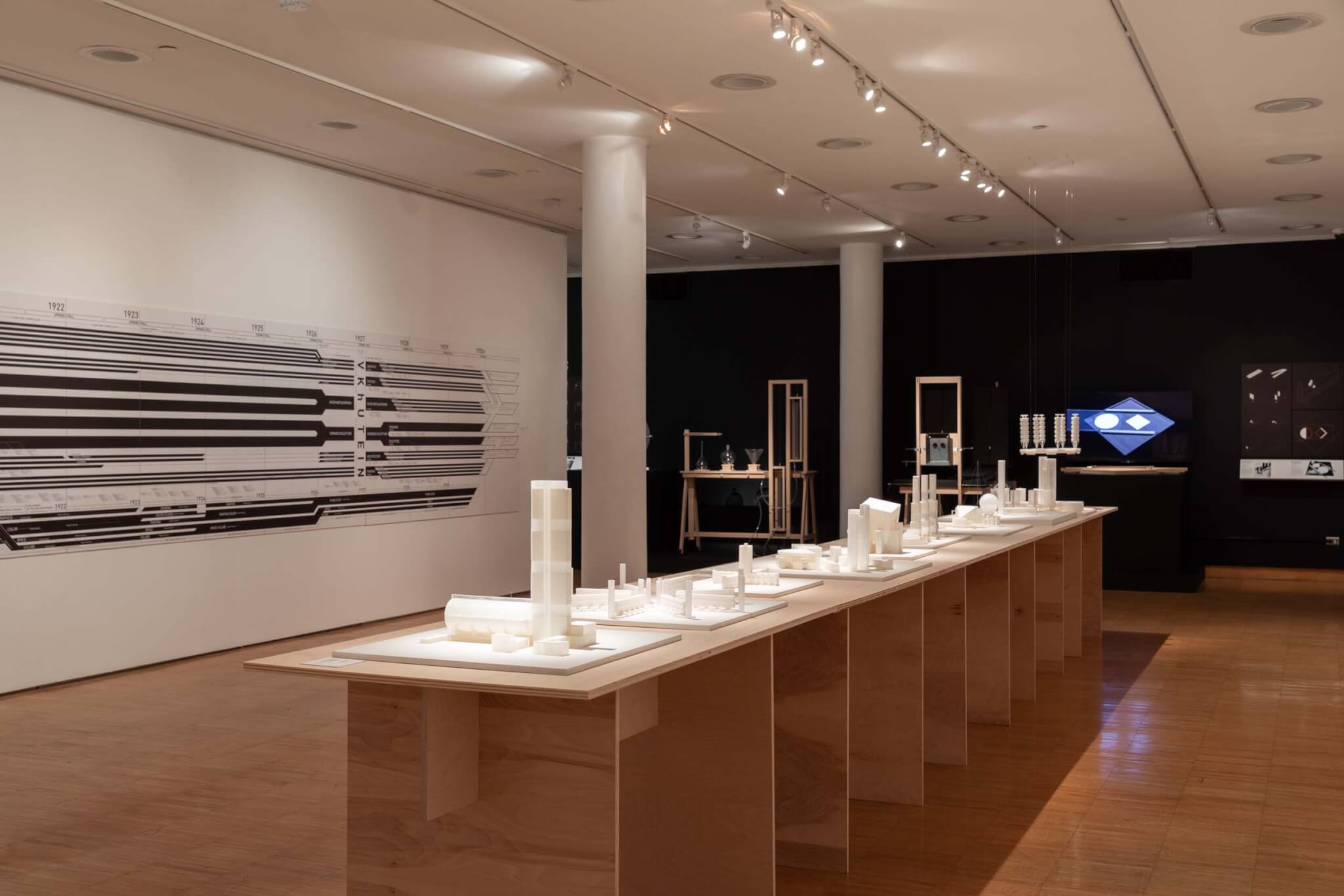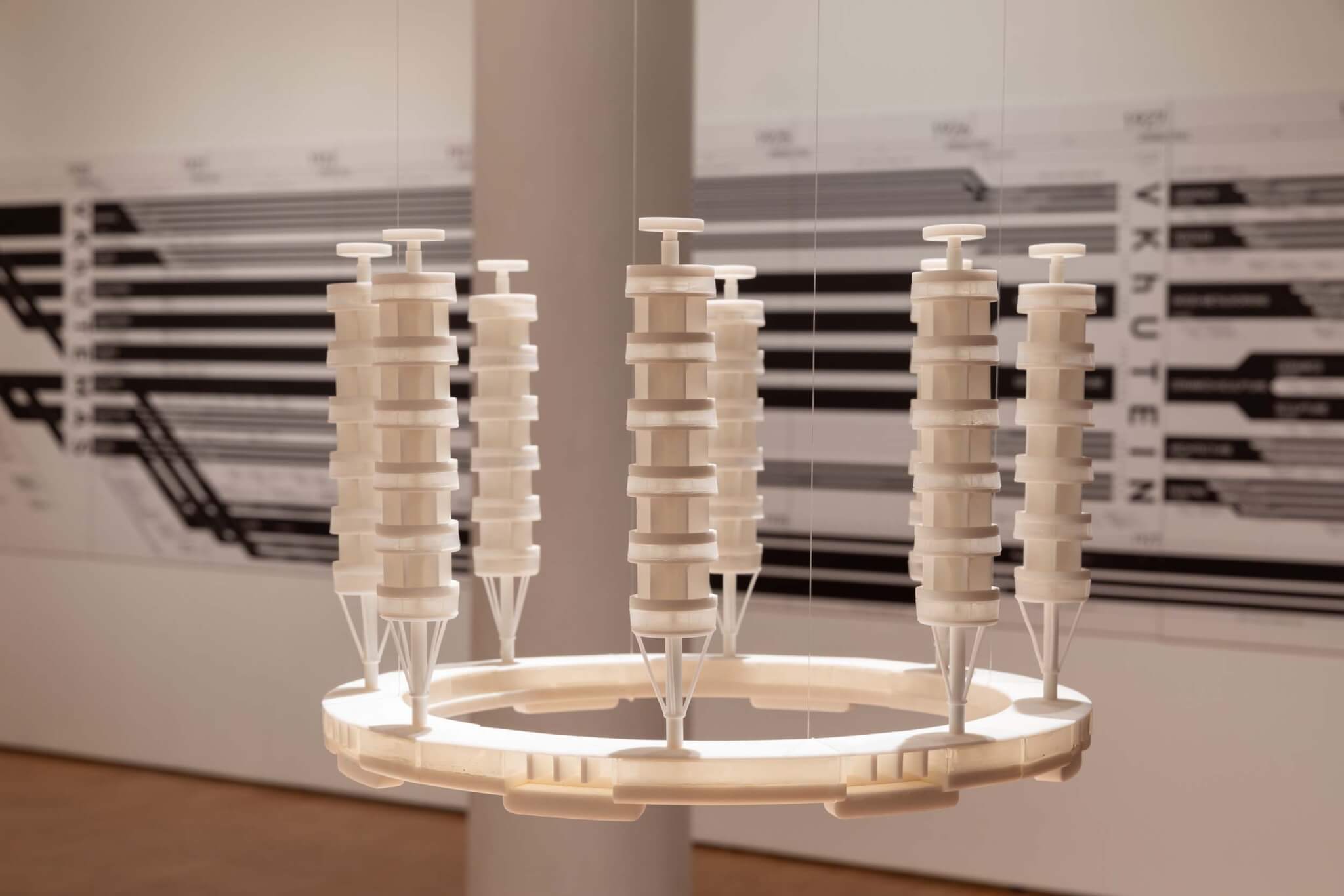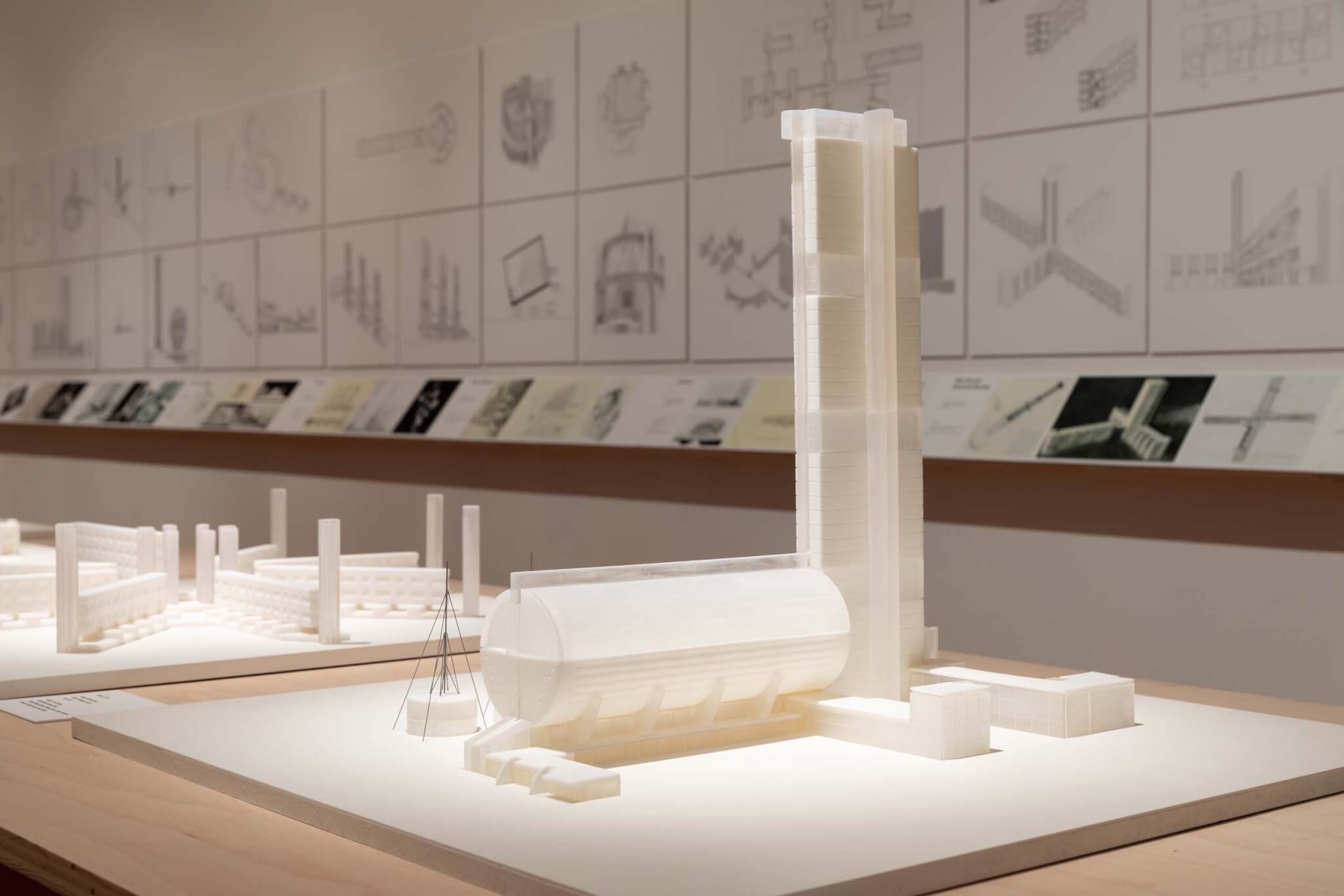Vkhutemas: Laboratory of Modernism, 1920–1930
The Cooper Union
New York
April 25–May 5
How to learn architecture? The question has plagued scholars from Leon Battista Alberti to Bruno Zevi. The answer might constitute an originating kernel of pedagogy or the educational structure through which one acquires knowledge of a subject. (“I will learn you architecture!” Herman Hertzberger reportedly told his students at the Berlage Institute.) Popular models come and go. For decades, the standard was set by the École des Beaux-Arts in Paris and then replaced by the Bauhaus’s centripetal progress from a preliminary form and materials course inward (and upward) toward the creation of buildings. Another variant emerged from John Hejduk’s tenure at The Cooper Union in New York, during which the architect established a set of exercises that prized abstraction and visual play infused with a certain poetics.
The Cooper Union, then, is an ideal place for an exhibition about an important—and underappreciated—moment in the history of architecture pedagogy: Vkhutemas, the Russian Higher Art and Technical Workshop, which trained students from across the Soviet Union in a variety of disciplines beginning in 1920 and continuing until Stalin shuttered the school in 1930.

Vkhutemas is often pitched as “Soviet Moscow’s Bauhaus,” but the epithet doesn’t really fit, as the student body of the former was an order of magnitude larger than that of the latter: 2,000 versus 200 pupils. Though the work produced at Vkhutemas was widely published during the 1920s, its legacy fared worse than its German counterpart. The Bauhaus’s leadership largely escaped to academic positions in America, while few Vkhutemas instructors were as lucky: Rationalist Nikolay Ladovsky, a leading figure at the school, remained in Moscow after 1930 and worked as an architect before fading into obscurity and dying in 1941, possibly from suicide. Alfred H. Barr Jr., the Museum of Modern Art’s (MoMA) first director, omitted Vkhutemas from his diagram that charted the lineages of modern art (the Bauhaus was included), and though he exhibited work by Soviet artists who taught at Vkhutemas, there was no mention of the institution, a treatment that differed from the display of art by Bauhaus faculty. While much ado was made of the Bauhaus’s centennial in 2019, similar accolades were not extended the following year for Vkhutemas.
This is useful background information for Vkhutemas: Laboratory of Modernism, 1920–1930, which was on view at The Cooper Union for a mere 77 hours this spring. When one approached the Arthur A. Houghton Jr. Gallery, a historical timeline and initial diagrams lined corridor walls, but inside, a separate impressive world of knowledge was on display.
Expertly curated by Anna Bokov, assistant professor adjunct at The Irwin S. Chanin School of Architecture, and Steven Hillyer, director of The Irwin S. Chanin School of Architecture Archive, the show featured the work of 27 students who, over the course of two seminars and a workshop, studied, reproduced, and extended artifacts from Vkhutemas. (Early versions of some of the projects were on view in the school’s virtual End of Year show in 2020.) The engaging results vivified projects that went largely unencountered for a century.

The curators organized the show around five themes: Instruments, Constructions, Objects, Exercises, and Projects. After encountering a detailed flowchart of the school’s departments and faculty, viewers first confronted the Projects section. In it, ten Vkhutemas diploma projects were re-created by Cooper Union students as both drawings and models. Wall-mounted drawings showed the designs in orthographic form and as Arctic-mode rendered views that expanded on archival documentation, allowing new encounters with recognizable schemes like Georgy Krutikov’s New (Flying) City, Rachel Smolenskaya’s House of Congresses, and Ivan Leonidov’s Lenin Institute for Librarianship. The models, realized at two different scales in consistent materials, encouraged formal comparisons between the designs.
On another wall, Objects showcased analytic drawings of furniture and consumer goods—white- and red-lined axonometrics on black backgrounds—while a display cycled through animations made by Cooper Union students of the objects in assembly, such as a teapot folding into its carrying case.
The Constructions section witnessed the rebuilding of artistic experiments of Vkhutemas professor Alexander Rodchenko, who in 1920 developed a set of serial groupings of unitized blocks according to his “principle of equal form.” Cooper Union students both drew the combinations and built them anew with pieces of lumber.
Exercises staged a set of space teaching experiments developed by Ladovsky. He had proposed using math to create combinatorics, which studied the arrangement of 2D shapes, as a basis for architecture as a science. Students would then be tested on their ability to array primitive shapes along one, two, three, or four axes, the most complex of which might yield over 3,000 unique arrangements. Present-day Cooper Union students used computer scripting to quickly visualize all of them, which flickered past on a screen. Ladovsky also developed a set of space exercises wherein students manipulated mass to express proportional relationships in a way that prized “dual rationality,” based on the conservation of materials but also of “[psychic] energy.”

The course on spatial experiments was a success and quickly entered Vkhutemas’s core curriculum by 1923. Its visual outputs were some of the most striking results of the entire school’s output, seen in a series of abstracted, intersected forms modeled in clay and other materials and documented like sculptures. (One such image appears on the cover of Bokov’s Avant-Garde as Method: Vkhutemas and the Pedagogy of Space, 1920–1930, her archivally rich publication about the school, a gallery copy of which was within arm’s reach on a nearby tall socle.) These objects are nearly incomparable across the universe of architectural imagery. Cooper Union students re-created a handful of the pieces with some invention: Many survive only in single photographs, so the backsides and scales of the pieces had to be imagined and then modeled.
Instruments, the final theme, yielded the most jaw-dropping results. Cooper Union students studied “psychotechnical laboratory devices” used by Vkhutemas for evaluation of both 2D and 3D geometries, digitally modeling them and building three full-size versions in wood. One contraption, a volume-eye-meter, tested the ability to match volumes within beakers of varying shapes, while another challenged eyes, peering through a viewing device, to register dashes as aligned. A third, which had a lined element slide over a circle and a square, tested the recognition of equal-sized areas cut from the two different shapes. Scale was again the issue: Like detectives, Cooper students estimated the apparatus’s size based on a photograph with a hand in the frame. The trio of training machines brought the history of Vkhutemas to life in a measurable, bodily way.
The principal tragedy of the show is that it was on view for less than two weeks: Its delay from its originally scheduled run earlier in the year meant the contents were wedged between another display and the school’s final reviews and End of Year show. There were no politics in the show, but it faced political setbacks, as opponents said the effort was inappropriate given Russia’s invasion of Ukraine and The Cooper Union’s location within the neighborhood of Ukrainian Village. (AN consistently covered the controversy online.) The resulting decision was to move forward with nuance after talks with the Cooper Union and Ukrainian communities, and the show was supplemented by a quartet of helpful contextualizing texts. The school also held a roundtable for students to present their work on Vkhutemas and engage in dialogue about its contemporary resonances.
Unrelated to the exhibition’s contents but held during its run, the school conducted a public program in which experts shared highlights of Ukrainian cultural achievements in the first part of the 20th century, noted the cultural legacy lost in Ukraine during Stalin’s reign, and spoke in solidarity with the Ukrainian people, who are defending their country even as you read this review. According to The Cooper Union, about 150 people attended. Decades earlier, Hejduk stated his belief “that the University is one of the last places that protects and preserves freedom, therefore teaching is also a socio/political act, among other things.” That same liberty seems to be widely under attack from both within and outside universities today.

The senseless violence of Russia’s ongoing war is paired with the microscopic, misplaced aggression of reactionaries who sought to kneecap what is essentially a display of virtuosic undergraduates who Rhino-modeled their way through the depths of the pandemic. Vkhutemas should be uplifted as a model for education today. As Bokov wrote in her curatorial statement,
the school fostered a culture of collaboration and creativity that transcended the boundaries of class, gender, and nationality, and even questioned the established hierarchy between students and teachers. The school offered free education and accepted students from underprivileged social classes—many of whom lacked secondary education—regardless of their artistic talent or academic standing. It opened its doors to students from diverse national backgrounds, some of whom previously did not have access to higher education. Vkhutemas was also one of the first design schools to foster gender equality—women enrolled in all disciplines, including architecture, on equal footing with men.
The story of Vkhutemas offers an example of progressive activity that is politically and aesthetically rigorous at the same time.
The show’s subject matter is its rightful focus, and its existence evidences The Cooper Union’s history of pedagogical rigor and the talent of its students. In his curatorial statement, Hillyer notes that the students’ work “speaks to and engages with a tradition of formal analysis in the School of Architecture that spans decades, design studios, and seminar courses alike.” That lineage is enhanced using digital tools, which allowed the interpretation of historic artifacts into a plethora of new visualizations. Though the show’s run was too short, thankfully the work of Cooper Union students on the subject is being compiled into a catalog that will arrive by the end of the year.
Halfway between today and Vkhutemas’s ten years of operation, student work from The Cooper Union was on view at MoMA in 1971 in the exhibition Education of an Architect. (Imagine if that were to happen today!) The show was aligned with a publication of the same name edited by Hejduk, which was followed by a sequel in 1988, also with the same name but edited by Elizabeth Diller, Diane Lewis, and Kim Shkapich. Though the volumes aren’t immune to contemporary critique—in 2012, Peggy Deamer called the latter “American formalism usurping Continental intelligentsia”— they establish an orthodoxy whose visuals, seen again, can be read as descended from Vkhutemas. Many other capital-P projects were, too. It’s easy to read up on Rem Koolhaas’s early interest in the Soviet avant-garde, which informed much of OMA’s work: A clear line of inspiration connects the sphere in Leonidov’s thesis project in 1927 to OMA’s Zeebrugge Sea Terminal from 1988, about 60 years later.
The Cooper Union’s show collapses a century of history onto itself: If the archival imagery was removed, the recent efforts could convincingly be repackaged as the work of foundational studios taught today, an editorial thought experiment that showcases the consistency of architectural representation across the chasm of the 20th century. For 11 short days, the exhibition and its tribulations showed us how ahead of its time Vkhutemas was and how stuck in the past we are now.
A prior version of this article misstated the usage of four contextualizing texts. In addition to being available as press materials, they were also installed on the wall outside the Arthur A. Houghton Jr. Gallery at The Cooper Union.











